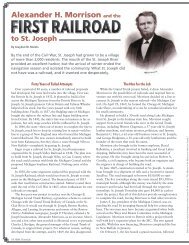The whaleback's profile was considered âgrotesqueâ by some ...
The whaleback's profile was considered âgrotesqueâ by some ...
The whaleback's profile was considered âgrotesqueâ by some ...
Create successful ePaper yourself
Turn your PDF publications into a flip-book with our unique Google optimized e-Paper software.
McDougall stands far right inside the hold of a whaleback under construction. Courtesy of the Northeast Minnesota Historical Center.<br />
Moving ice floes then pushed the 300-foot freighter several<br />
miles from the site of the encounter. A reward <strong>was</strong> offered to<br />
anyone who could find the whaleback, which <strong>was</strong> eventually<br />
discovered with more than seven feet of water over its decks.<br />
<strong>The</strong> Cort <strong>was</strong> raised and repaired at a cost of more than a<br />
quarter of a million dollars. It then sank again after running<br />
into rocks at Ballard’s Reef in the Livingston Channel of the<br />
Detroit River. Eight plates were torn out in the accident,<br />
and First Mate Peter Pulcer noted that the pumps barely<br />
enabled the ship to make it to the community of River<br />
Rouge. <strong>The</strong>re, the Cort settled on the bottom of the river.<br />
Another $100,000 <strong>was</strong> invested to manufacture and install<br />
cranes on its deck to load scrap metal.<br />
<strong>The</strong> Cort’s final run <strong>was</strong> attempted from Holland,<br />
Michigan to Chicago. On November 30, 1934, 60-mph<br />
winds spun the freighter around just 30 miles from its<br />
destination. Captain Charles Cox, one of the youngest<br />
skippers on the Great Lakes, opted to sail back toward<br />
the Michigan shoreline for protection. Near Muskegon,<br />
he attempted to put the Cort between the breakwalls. <strong>The</strong><br />
captain later told newsreel reporters, “As we were coming<br />
through the piers, the sea caught us on our starboard side<br />
and landed us over onto the north breakwater, smashing a<br />
hole in our side. We backed her and landed alongside the<br />
breakwater, where she filled with water and sank in five<br />
minutes.” Luckily for the crew, the main deck and cabins<br />
were still above the water line.<br />
Coast guardsmen at Muskegon were immediately<br />
dispatched to the scene; tragically, their lifeboat overturned<br />
in the waves, drowning Surfman John “Jack” Dipert.<br />
Newspapers mistakenly reported that the Cort crew <strong>was</strong><br />
dead after the first rescue attempt. <strong>The</strong> headlines changed<br />
late that day to “All Aboard Safe,” when rescuers managed to<br />
shoot a line to the ship and utilize a breeches buoy to carry<br />
each crew member to safety. <strong>The</strong> 25 men were then tied<br />
together and escorted along the 3,000-foot rock structure to<br />
the shore.<br />
It <strong>was</strong> estimated that more than 50,000 people swarmed<br />
the wreck site to get a look at the half-sunken Cort.<br />
Automobile accidents put four people in the hospital, and<br />
traffic <strong>was</strong> lined up for nearly three miles leading to the<br />
Coast Guard station. Overzealous photographers also put<br />
themselves at risk, with a photographer from the Chicago<br />
Tribune requiring rescue after going out onto the breakwall.<br />
Interestingly, the Cort <strong>was</strong> already well known in<br />
Muskegon, having visited at least four times prior with<br />
pig iron for the Campbell, Wyant, and Cannon Foundry.<br />
On one of those visits, the whaleback had rammed into<br />
a fishing boat; two fishermen drowned in the process.<br />
Government inspectors later cleared the command crew of<br />
any wrongdoing.<br />
Now a permanent resident of Muskegon, the Cort lies<br />
in pieces on the bottom of Lake Michigan near the shore.<br />
<strong>The</strong> bow of the ship remains but sections of the hull have<br />
been salvaged, leaving only a few plates and a large gear<br />
that presumably turned the crane. Large carp and other fish<br />
swim in and out of the wreckage, which is usually clouded<br />
from wave action near the breakwall.<br />
In addition to storms, collisions with other ships<br />
have added to the Great Lakes’ underwater collection of<br />
whalebacks. <strong>The</strong> barge Sagamore <strong>was</strong> lost near Sault Ste.<br />
Marie in 1901, and the steamer Thomas Wilson sank near<br />
Duluth the next year. <strong>The</strong> Wilson <strong>was</strong> dynamited as a<br />
navigation hazard, but the Sagamore remains largely intact<br />
30 | michigan history







